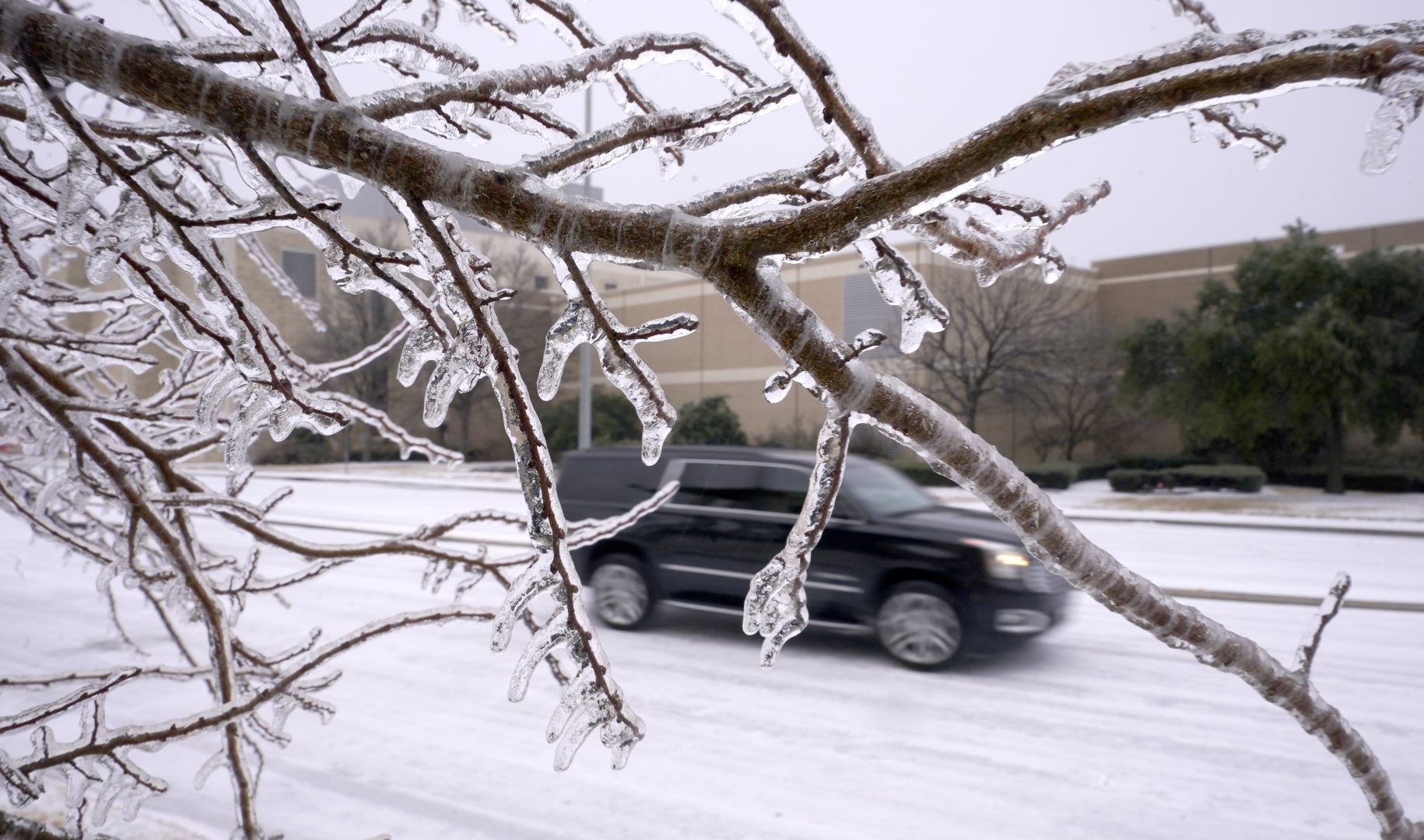
Ice coats trees and the road as an SUV drives in Richardson, Texas, Thursday, Feb. 3, 2022. A major winter storm with millions of Americans in its path is spreading rain, freezing rain and heavy snow further across the country. (AP Photo/LM Otero)

Ice coats trees and the road as an SUV drives in Richardson, Texas, Thursday, Feb. 3, 2022. A major winter storm with millions of Americans in its path is spreading rain, freezing rain and heavy snow further across the country. (AP Photo/LM Otero)

Ice coats trees and the road as an SUV drives in Richardson, Texas, Thursday, Feb. 3, 2022. A major winter storm with millions of Americans in its path is spreading rain, freezing rain and heavy snow further across the country. (AP Photo/LM Otero)
Arborists are encouraging homeowners to prepare their trees for winter storms, heavy snow, and ice, which can damage trees if they have weak structures.
Jason Parker, an arborist at the Davey Tree Expert Company, said there’s a lot of risks when it comes to trees in the winter.
“The biggest ones typically are going to be storm-related. Snow and ice buildup on softer trees can lead to breakage,” he said. “Sometimes, saturated soils can lead to complete tree failure and uprooting.”
If you notice major changes in your tree, such as dead branches or abnormal leaf loss, it may be time to call a professional arborist, said Tim Ifill, an arborist at the Pennsylvania Horticultural Society. An arborist can prune your tree — a strengthening process that involves removing dead branches.
“Make sure you tell them you’re not looking to remove the tree, but you’re looking to preserve it and make sure it stays healthy,” Ifill said. “And that’s a good way to make sure someone isn’t trying to sell you on tree removal services.”
Pruning is typically done mid-December through the end of February, when the trees are dormant, he said. Ifill recommends pruning a young tree — around 3 to 5 years old — to set it up for long-term success.
Pruning will ensure trees don’t catch as much wind or hold as much snow, Parker said. He stressed the importance of pruning during a tree’s dormancy when insects and disease aren’t present.
Deciduous trees, which lose their leaves in the winter, can be damaged if they’re not pruned. Meanwhile, evergreens face another challenge because they maintain their needles year-round, Parker said. He recommends spraying evergreen leaves, which can dry out, with anti-desiccant — a solution that traps moisture.
Parker said fertilizing trees in the spring can also strengthen them before winter.
During the winter, tree owners should remove green gator bags, which slowly release water for newly planted trees, Ifill said. These bags can attract moisture at the trunk of the tree, which can lead to rotting and decay. Rodents also can seek shelter in the bags during cold temperatures, and chew on bark and roots.
Deer can also present a problem for trees during the winter, the arborists said. They sometimes eat leaves and twigs and can rub their antlers on trunks. Ifill recommends installing a barrier around vulnerable young trees, while Parker suggests putting deer repellant on trees.
Trees become dormant in the winter. However, warming temperatures caused by climate change may prevent a tree from going dormant, which can cause insect and disease-related problems, Parker said.
“Those cold winter temperatures that we’re used to getting can help eliminate a lot of those insects and overwintering eggs,” he said. “We’re having to change our strategy as to exactly how we deal with a warmer winter season.”
If you’re concerned about a neighboring tree, find out who owns it and speak to them, Parker suggests. The responsibility to clean up a fallen tree always falls on the property owner, even if they don’t own it, he said.
“Let them know your concern, and see if they’re willing to do something preventative,” Parker said. “None of us want to deal with something after the fact. Storm damage and insurance claims is something most people would want to avoid. So reach out, and hopefully they’re a good neighbor.”
If you live in Philadelphia and you’re concerned about the health of a street tree, you can contact the city’s Parks and Recreation Department. The department will contract arborists to prune public trees in need.
Urban trees require a lot of maintenance, including planting new trees to replace trees that die, Ifill said.
“Managing the urban forest is a story of lost trees, and newly planted trees, and establishing trees, and long-term maintenance,” he said. “We really encourage all the municipalities we work within our area to have good proactive tree maintenance as part of their urban and community forest management strategies.”

Sometimes, your mornings are just too busy to catch the news beyond a headline or two. Don’t worry. The Morning Agenda has got your back. Each weekday morning, host Tim Lambert will keep you informed, amused, enlightened and up-to-date on what’s happening in central Pennsylvania and the rest of this great commonwealth.
The days of journalism’s one-way street of simply producing stories for the public have long been over. Now, it’s time to find better ways to interact with you and ensure we meet your high standards of what a credible media organization should be.